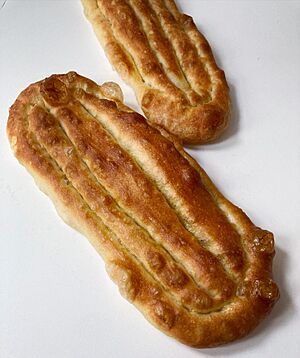Cañada bread facts for kids
Pan de cañada (which means "drovers' road bread" in Spanish) is a tasty flatbread from the center and south of Aragon, a region in northern Spain. It's also often just called cañada. This bread has a long, rounded shape, but its size can change a lot. You'll notice special grooves or dimples on its surface. These are made to hold extra virgin olive oil, which gives it a wonderful flavor!
The inside of the bread, called the crumb, is very moist and soft, with lots of small, uneven holes. The outside crust is golden, shiny, thin, and a little bit crunchy. Cañada breads can be either sweet or savory, depending on what you like. Bakers in different towns might even make it in different shapes, like rectangular, oval, or elliptical, and in various sizes.
Cañada bread and other flatbreads have a special job in the bakery. They are often the first breads to go into the oven. This helps to lower the oven's temperature and add more moisture, getting it ready for the next batches of bread. Pan de cañada is most traditional in Lower Aragon, but it has become popular all over Aragon. This is thanks to the shepherds who used to move their animals long distances. They would eat this bread during their journeys along special paths called "drovers' roads" or cañadas in Spanish – that's where the bread gets its name! The olive oil in the bread acts like a natural way to keep it fresh, so the bread could stay soft for the many weeks their trips lasted. Even though it's a simple bread with oil, the recipe can be quite different from one town to another in Aragon.
Since 2008, cañada bread has been part of the C'Alial brand. This is a special quality seal from the Government of Aragon, which means it meets high standards. Other traditional Spanish breads like the chusco, the pintadera bread from Teruel, and the pan de cinta from Zaragoza are also part of this brand.
Different Names for Cañada Bread
This special bread has many different names depending on where you are in Aragon!
- In Híjar, it's called raspao.
- In Cariñena, people call it guitar.
- In Calamocha, it's known as bollo.
- In Biel, it's called torta floja.
- In other towns, you might hear it called sequillo.
See also
 In Spanish: Pan de cañada para niños
In Spanish: Pan de cañada para niños


